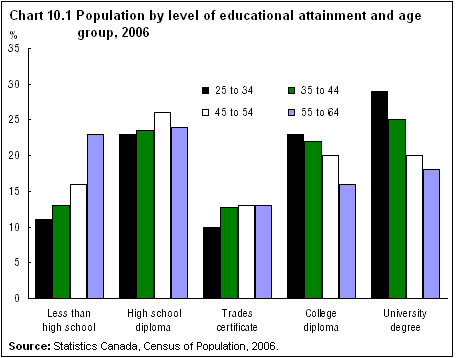Education, training and learning
Archived Content
Information identified as archived is provided for reference, research or recordkeeping purposes. It is not subject to the Government of Canada Web Standards and has not been altered or updated since it was archived. Please "contact us" to request a format other than those available.
Related information
Canada leads the Organisation for Economic Co-operation and Development (OECD) countries with the highest proportion of adults who have either a college or university degree. In 2006, some 23% of Canadians had a university degree. An additional 20% had a college degree; 12% had a trades certificate.
Almost one in four adults aged 25 to 64—a total of 4,156,700 people—had a high school diploma as their highest level of educational attainment, while 15%, or 2,683,500 people, had less than a high school education. Canadians with no formal education were concentrated in older age groups.
Growth in university degree holders
At the time of the 2006 Census, Canada had 17,382,100 adults aged 25 to 64. The number with a university degree totalled 3,985,700, a 24% increase from the 3,207,400 with degrees in 2001. In comparison, the number of adults who did not have a university degree rose 2%.
Not surprisingly, young adults have a higher level of educational attainment than their older counterparts. In 2006, 29% of young adults aged 25 to 34 had a university degree, well above the proportion of 18% among adults aged 55 to 64.
In 2006, 44% of Aboriginal people were postsecondary graduates: 14% had trade credentials, 19% had a college diploma and 8% had a university degree.
Also, a much higher percentage of women than men aged 25 to 34 have a university degree: 33% of women versus 25% of men. However, in older age groups, the situation was reversed: among older adults (aged 55 to 64), 16% of women had a university degree versus 21% of men.
Educated Canadians tend to be more mobile. University degree holders accounted for 23% of the adult population aged 25 to 64 in 2006, but they comprised 33% of the people who moved to another province or territory between 2001 and 2006. Alberta and British Columbia had the biggest net inflows of postsecondary graduates, whereas Ontario recorded the biggest net outflows.
A smaller proportion of young adults are studying in trades than their parents. About 10% of adults aged 25 to 34 had a trade certification in 2006, compared with 13% of adults aged 55 to 64. Not only are there fewer young adults studying trades, but they are also choosing different trades than their parents. For example, fewer young adults than older adults have a trade certificate in mechanic and repair technologies. On the other hand, more young adults than older adults have a certificate in personal and culinary services.

View data source for chart 10.1
Immigrants highly educated
The 2006 Census counted 4,076,700 people aged 25 to 64 born outside of Canada. Among these immigrants, 1,287,500 people, or one-third (32%), had a university degree.
Over half (51%) of recent immigrants—those who arrived from 2001 to 2006—had a university degree in 2006. This was more than twice the proportion of degree holders among the Canadian-born population (20%), and was also higher than the proportion of 28% among immigrants who arrived before 2001.
Although 23% of Canadians aged 25 to 34 were born outside of Canada, they account for nearly half (49%) of the doctorate holders in Canada and 40% of adults with a master's degree.
- Date modified:

